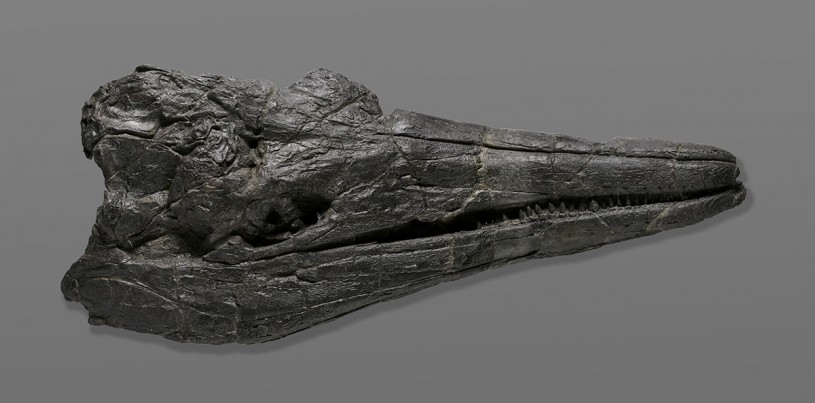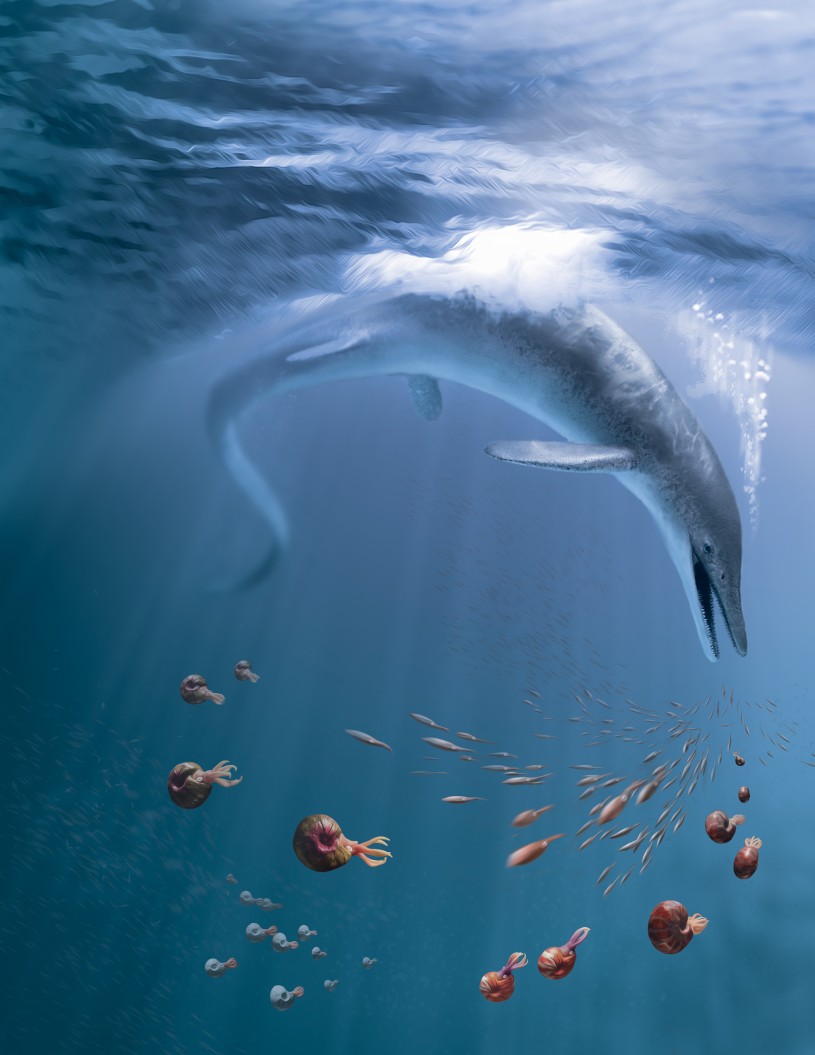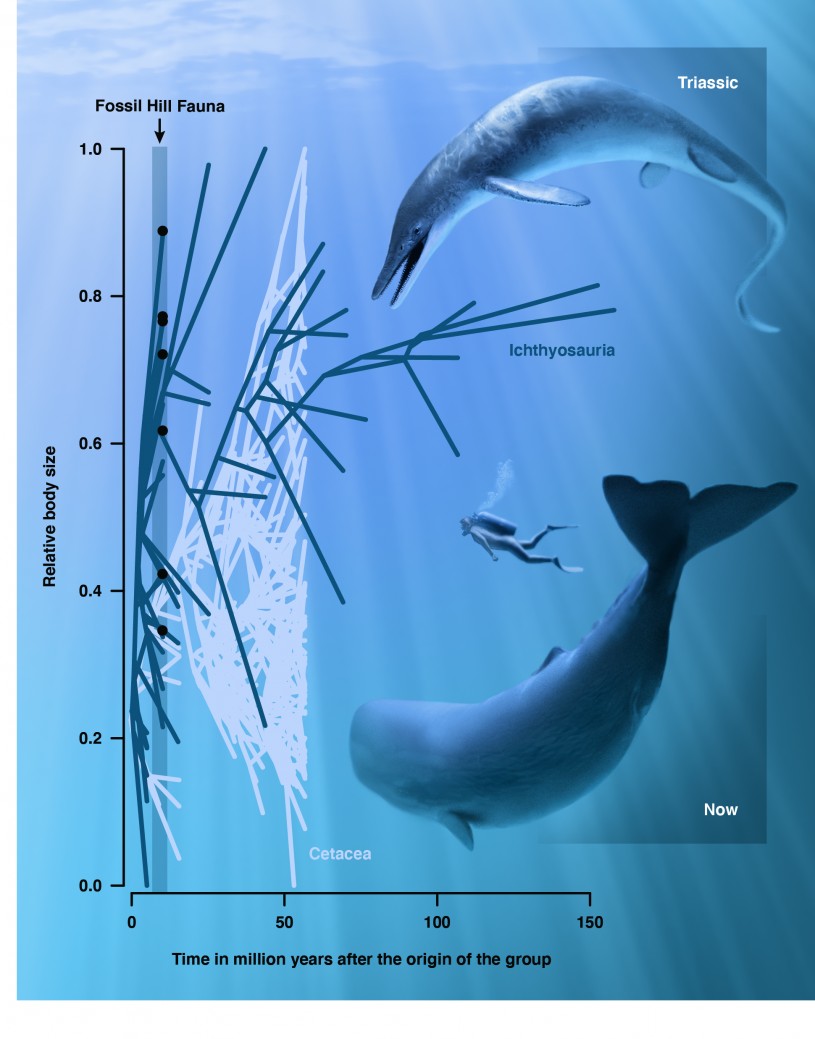Earth's First Giant
The two-meter skull of a humongous new ichthyosaur species, Earth’s first known giant creature, reveals how both the extinct marine reptiles and modern whales became giants.

The two-meter skull of a newly discovered species of giant ichthyosaur, the earliest known, is shedding new light on the marine reptiles’ rapid growth into behemoths of the Dinosaurian oceans, and helping us better understand the journey of modern cetaceans (whales and dolphins) to becoming the largest animals to ever inhabit the Earth.

While dinosaurs ruled the land, ichthyosaurs and other aquatic reptiles (that were emphatically not dinosaurs) ruled the waves, reaching similarly gargantuan sizes and species diversity. Evolving fins and hydrodynamic body-shapes seen in both fish and whales, ichthyosaurs swam the ancient oceans for nearly the entirety of the Age of Dinosaurs.
Excavated from a rock unit called the Fossil Hill Member in the Augusta Mountains of Nevada, the well-preserved skull, along with part of the backbone, shoulder, and arm, date back to the Middle Triassic (247.2-237 million years ago), representing the earliest case of an ichthyosaur reaching epic proportions. As big as a large sperm whale at more than 17 meters (55.78 feet) long, the newly named Cymbospondylus youngorum is the largest animal yet discovered from that time period, on land or in the sea.

Illustration by Stephanie Abramowicz
In other mountain ranges of Nevada, paleontologists have been recovering fossils from the Fossil Hill Member’s limestone, shale, and siltstone since 1902 opening a window into the Triassic. The mountains connect our present to ancient oceans and have produced many species of ammonites, shelled ancestors of modern cephalopods like cuttlefish and octopuses, as well as marine reptiles, specimens collectively known as the Fossil Hill Fauna, representing many of C. youngorum’s prey and competitors.

C. youngorum stalked the oceans some 246 million years ago, or only about three million years after the first ichthyosaurs got their fins wet, an amazingly short time to get this big. The elongated snout and conical teeth suggest that C. youngorum preyed on squid and fish, but its size meant that it could have hunted smaller and juvenile marine reptiles as well.
The giant predator likely had some hefty competition. Through sophisticated computational modeling, the authors examined the likely energy running through the Fossil Hill Fauna’s food web, recreating the ancient environment through data, finding that marine food webs were able to support a few more colossal meat-eating ichthyosaurs. Ichthyosaurs of different sizes and survival strategies proliferated, comparable to modern cetaceans’— from relatively small dolphins to massive filter-feeding baleen whales, and giant squid-hunting sperm whales.
Whales and ichthyosaurs share more than a size range. They have similar body plans, and both initially arose after mass extinctions. These similarities make them scientifically valuable for comparative study. The authors combined computer modeling and traditional paleontology to study how these marine animals reached record-setting sizes independently.

They found that while both cetaceans and ichthyosaurs evolved very large body sizes, their respective evolutionary trajectories toward gigantism were different. Ichthyosaurs had an initial boom in size, becoming giants early on in their evolutionary history, while whales took much longer to reach the outer limits of huge. They found a connection between large size and raptorial hunting —think of a sperm whale diving down to hunt giant squid—and a connection between large size and a loss of teeth—think of the giant filter-feeding whales that are the largest animals ever to live on Earth.
Ichthyosaurs' initial foray into gigantism was likely thanks to the boom in ammonites and jawless eel-like conodonts filling the ecological void following the end-Permian mass extinction. While their evolutionary routes were different, both whales and ichthyosaurs relied on exploiting niches in the food chain to make it really big.

“This discovery and the results of our study highlight how different groups of marine tetrapods evolved body sizes of epic proportions under somewhat similar circumstances, but at surprisingly different rates,” says NHM’s Associate Curator of Mammalogy (Marine Mammals), Dr. Jorge Velez-Juarbe. “Moving forward, with the dataset we’ve compiled and analytical methods we've tested, we can start thinking about including other groups of secondarily aquatic vertebrates to understand this aspect of their evolutionary history.”
